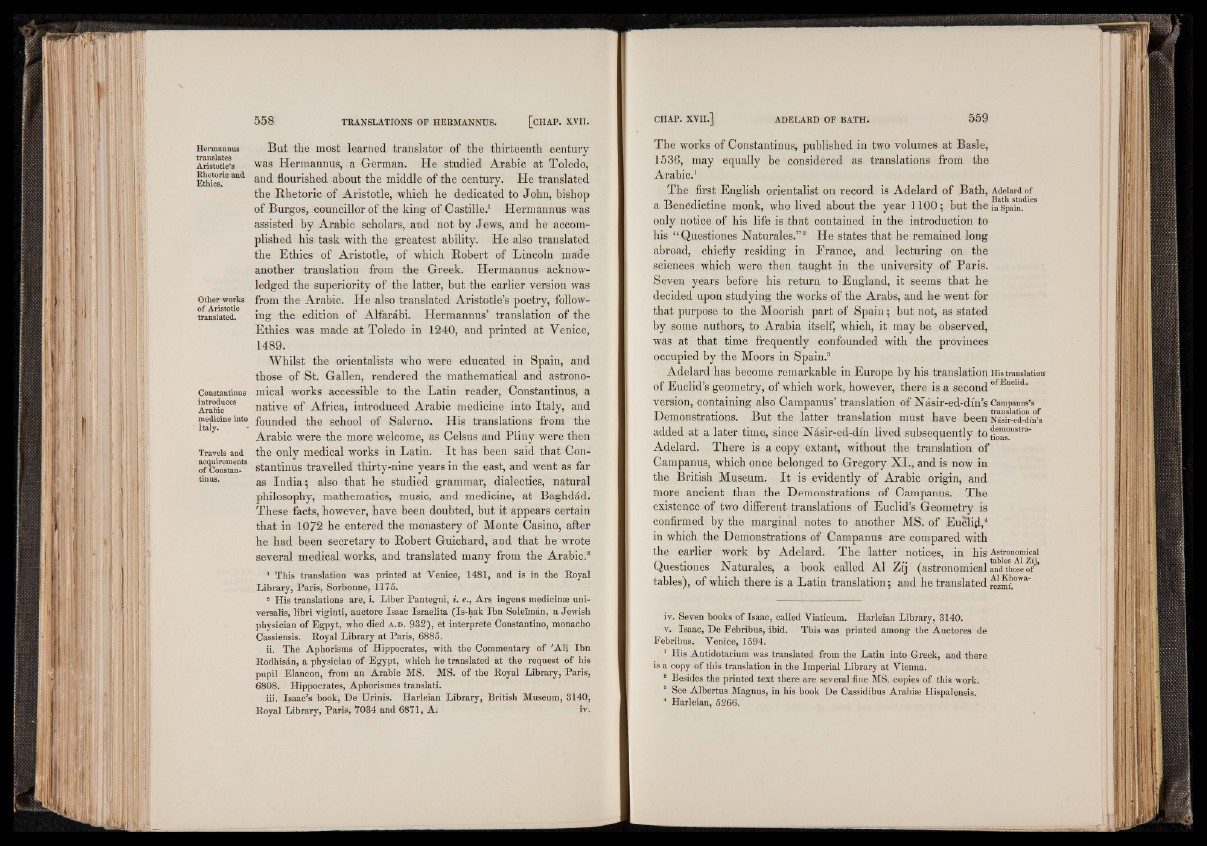
Hermannus
translates
Aristotle’s
Ehetoric and
Ethics.
Other works
of Aristotle
translated.
Constantinus
introduces
Arabic
medicine into
' Italy.
Travels and
acquirements
of Constantin
us.
Bat the most learned translator of the thirteenth century
was Hermannus, a German. He studied Arabic at Toledo,
and flourished about the middle of the century. He translated
the Rhetoric of Aristotle, which he dedicated to John, bishop
of Burgos, councillor of the king of Castille.1 Hermannus was
assisted by Arabic scholars, and not by Jews, and he accomplished
his task with the greatest ability. He also translated
the Ethics of Aristotle, of which Robert of Lincoln made
another translation from the Greek. Hermannus acknowledged
the superiority of the latter, but the earlier version was
from the Arabic. He also translated Aristotle’s poetry, following
the edition of Alfarabi. Hermannus’ translation of the
Ethics was made at Toledo in 1240, and printed at Venice,
1489.
Whilst the orientalists who were educated in Spain, and
those of St. Gallen, rendered the mathematical and astronomical
works accessible to the Latin reader, Constantinus, a
native of Africa, introduced Arabic medicine into Italy, and
founded the school of Salerno. His translations from the
Arabic were the more welcome, as Celsus and Pliny were then
the only medical works in Latin. It has been said that Constantinus
travelled thirty-nine years in the east, and went as far
as India ; also that he studied grammar, dialectics, natural
philosophy, mathematics, music, and medicine, at Baghdad.
These facts, however, have been doubted, but it appears certain
that in 1072 he entered the monastery of Monte Casino, after
he had been secretary to Robert Guichard, and that he wrote
several medical works, and translated many from the Arabic.2
1 This translation was printed at Venice, 1481, and is in the Eoyal
Library, Paris, Sorbonne, 1175.
2 His translations are, i. Liber Pantegni, i. e., Ars ingens medicinae universalis,
libri viginti, auctore Isaac Israelita (Is-hak Ib n Soleiman, a Jewish
physician of Egpyt, who died a .d . 932), et interprete Constantino, monacho
Cassiensis. Royal Library at Paris, 6885.
ii. The Aphorisms of Hippocrates, with the Commentary of ’Ali Ib n
Rodhisdn, a physician of Egypt, which he translated at the request of his
pupil Elancon, from an Arabic MS. MS. of the Royal Library, Paris,
6808. Hippocrates, Aphorismes translati.
iii. Isaac’s book, De Urinis. Harleian Library, British Museum, 3140,
Royal Library, Paris, 7034 and 6871, A; iv.
The works of Constantinus, published in two volumes at Basle,
1536, may equally be considered as translations from the
Arabic.1
The first English orientalist on record is Adelard of Bath, Adeiard of
a Benedictine monk, who lived about the year 1100; but theinsPam.
only notice of his life is that contained in the introduction to
his “ Questiones Naturales.”2 He states that he remained long
abroad, chiefly residing in France, and lecturing on the
sciences which were then taught in the university of Paris.
Seven years before his return to England, it seems that he
decided upon studying the works of the Arabs, and he went for
that purpose to the Moorish part of Spain; but not, as stated
by some authors, to Arabia itself, which, it may be observed,
was at that time frequently confounded with the provinces
occupied by the Moors in Spain.3
Adelard has become remarkable in Europe by his translation His translation'
of Euclid’s geometry, of which work, however, there is a second ofEuolld-
version, containing also Campanus’ translation of Nasir-ed-din’s Campanns’s ■
Demonstrations. But the latter translation must have been N&fr-ed-din’s
added at a later time, since Nasir-ed-dfn lived subsequently to fi™s°“Etra'
Adelard. There is a copy extant, without the translation of
Campanus, which once belonged to Gregory XI., and is now in
the British Museum. It is evidently of Arabic origin, and
more ancient than the Demonstrations of Campanus. The
existence of two different translations of Euclid’s Geometry is
confirmed by the marginal notes to another MS. of Euclid,4
in which the Demonstrations of Campanus are compared with
the earlier work by Adelard. The latter notices, in his Astronomical
Questiones Naturales, a book called A1 Zij (astronomical IndTh^lo^’
tables), of which there is a Latin translation; and he translated 1°wa~
iv. Seven books of Isaac, called Viaticum. Harleian Library, 3140.
v. Isaac, De Febribus, ibid. This was printed among* the Auctores de
Febribus. Venice, 1594.
1 His Antidotarium was translated from the Latin into Greek, and there
is a copy of this translation in the Imperial Library at Vienna.
2 Besides the printed text there are several line MS. copies of this work.
8 See Albertus Magnus, in his book De Cassidibus Arabise Hispalensis.
4 Harleian, 5266.